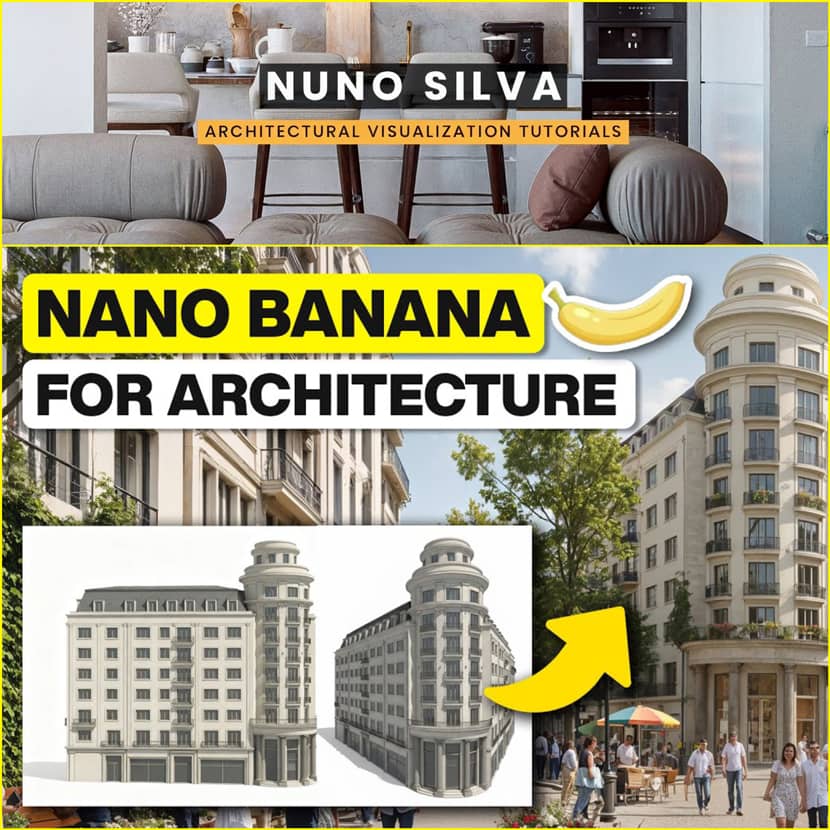
Nuno Silva takes us back to the forefront of innovation in the rapidly changing field of AI-assisted architecture design. He explores how architects and 3D artists can include Nano Banana into Lovart in his most recent tutorial. In ways that were unthinkable only a few months ago, artificial intelligence is being used to conceptualize, reinterpret, and even model architectural conceptions. Let’s explore five powerful techniques Nuno demonstrates that are set to transform your creative workflow!
1. Creating Architectural Concepts from Scratch.
Nuno begins by demonstrating how Nano Banana can produce architectural ideas straight from basic inputs, such as a freehand sketch, floor plan, or even a few words that describe the space. Working inside Lovart's unlimited canvas, he prompts the AI with "white sculptural villa in a pine forest, sunny morning" after uploading a hand-drawn drawing of the villa.
The technique creates a simple, minimalist concept render with realistic lighting and composition in a matter of seconds. Nuno emphasizes that succinct cues yield superior outcomes compared to excessively elaborate ones, demonstrating that simplicity might truly be the pinnacle of sophistication.
2. Editing Designs Effortlessly with Text or Scribbles.
What if all you had to do was type to add pieces, change lighting, or swap out materials in your render? Nuno demonstrates how Lovart's real-time semantic editing is made possible using Nano Banana.
For instance, the AI rapidly changes the image when you choose the villa's exterior and type "replace white with wood and put birds in the sky." Although the procedure seems nearly miraculous, it is entirely based on Lovart's user-friendly editing layer and Nano Banana's visual comprehension.
A major game-changer for early design exploration, the outcome is a quick, fluid workflow where iteration feels easy and enjoyable.
3. Turning Static Designs into Animated Storyboards.
Nuno shows how architectural scenes may be brought to life using Nano Banana's storyboard generation once the static image is complete. He wants Lovart to create keyframes for a video walkthrough using the same villa design.
He creates a fluid, cinematic animation that dynamically visualizes the environment by describing each scene and allowing the AI to interpolate transitions. This application removes the need for third-party animation software for idea presentations or client previews because everything takes place within Lovart's canvas.
4. Reimagining Interior Spaces in Seconds.
Nuno then advances Nano Banana into the field of change in interior design. He requests that the AI "redesign this in light wood, mid-century modern style, abstract artwork, white rug" when he uploads a picture of a living room.|
Nano Banana reinterprets the scene in a matter of seconds, changing the materials, lighting, and décor while maintaining the geometry. The change allows for countless style variations while preserving architectural accuracy.
This feature is a huge time-saver for designers who are experimenting with various moods or customer preferences.
5. From Google Street View to 3D Model.
Nuno demonstrates how Nano Banana can create 3D models from a single photograph in what is arguably the most striking example. He enters the following request using a Google Street View image of the well-known Nothing House in Prague: "Use the accompanying architectural photo as reference." Create a high-fidelity 3D building model that resembles an architecture model that has been 3D printed.
The AI produces a detailed miniature-like representation in 30 seconds. Then, in less than two minutes, he turns it into a downloadable 3D file utilizing Lovart's integrated 3D model generator.
Although Nano Banana uses context to fill in the blanks, accuracy can be increased by including a top or side view. However, the speed and accessibility of the workflow redefine what is feasible for model exploration and early-stage design.
A New Era of Creative Flow.
“What really makes Lovart + Nano Banana unique is how playful and intuitive the whole process feels,” Nuno said. There is only pure creation, no program switching or convoluted export workflow. Everything takes place on a single canvas, from modeling and animation to editing and drawing.
This is a significant advancement in conceptual visualization for students, CG artists, and architects alike. AI isn't meant to take the place of artistry; rather, it's meant to boost creativity and enable designers to test concepts more quickly than ever before.
This tool "fits organically into your workflow," says Nuno, particularly for people who enjoy rapidly sketching, iterating, and visualizing concepts. Never before has the line between creativity and execution been so thin.
Watch the full video tutorial and explore new ways to include in your daily workflow:
About Nuno Silva:
Nuno Silva is a Portuguese 3D artist with over a decade of professional experience, specializing in architectural visualization. Over the years, he has collaborated remotely with clients from around the world, producing high-quality renders for real projects built and sold in Canada, the USA, Portugal, and beyond. Beyond his client work, Nuno is also an educator, having taught thousands of students through his popular YouTube channel and online courses. His mission is to help aspiring artists build sustainable careers in 3D rendering — from mastering realism to optimizing workflows. Passionate about teaching, Nuno regularly shares tutorials, tips, and insights to help others grow from beginners into confident professionals.

